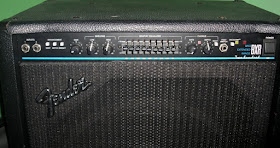This is an old Fender BXR 200 ("two hundred") bass combo amplifier. It's a massive 1 X 15" solid state combo equipped with a 200 Wrms power amp and a bass guitar preamp. It weighs 32.7kg. There was also a head version of the same amp. It has a 9 band parametric EQ with high and low shelving, "deep," "notch" and "bright" buttons, a "Delta-comp" compressor and an on-board chorus effect with foot-switch capability.
Here are its official specs:
Title/Item: Fender BXR 200 Bass Amp
Type: 200 Watts Solid State
Seller ID: LCDFenderBXR1
POWER AMPLIFIER SECTION:
Power output: 200W R.M.S.
Rated load impedance: 4 ½ Ohm
Distortion at 200 watts: Less than .1% @ 1 kHz, below compression
Less than 1% @ 1 kHz, maximum compression
Sensitivity: 1.03V R.M.S.
Input impedance: 22 k½ Ohm
DELTACOMP (tm) range: 20 dB
PREAMP SECTION:
Input impedance: Input 1 - Greater than 420 k½ (typically greater than 1 M½ in the passband)
Input 2 - 136 k½
Sensitivity for 200 W: Input 1 - 2.2 mV GAIN at maximum, all Input 2 - 4.4 mV tone controls at “0” detent, no enhancement activated.
Shelving tone controls: LOW +/- 12 dB at 60 Hz HIGH +/- 12 dB at 10 kHz
Graphic equalizer: +/- 12 dB at 80, 140, 250, 450, 800, 1.4k, 2.5k, 4.5k, and 8 kHz.
PHYSICAL SPECIFICATIONS:
(BXR 200 COMBO)
Height: 25-1/2 inches (64.8 cm)
Width: 21-1/2 inches (54.6 cm)
Depth: 13-1/2 inches (34.3 cm)
Weight: 72 lbs. (32.7 kg)
Speaker: 15",” 4 Ohm Fender Special Design woofer
Controls (left to right): Bass Boost, Mid Cut, Treb Boost, Gain, Shelving (low and high), 9 band EQ, Chorus rate and depth, Compressor.
(Source)
MANUALS:
Here is the user manual.
And here is the very useful fender bxr 200 schematic / service manual:
http://elektrotanya.com/fender_bxr-200_sch.pdf/download.html
The issues:
This amp had several problems due to its age and use over the years. The main problem with these amps is that some of their parts get really hot. For instance, the higher wattage resistors of the power amp section tend to get boiling hot in less than 30 minutes of operation. Most of these resistors are directly placed on the PCB... The heat produced by these components can melt and break solder joints, it can also cut some fine pcb traces, burn the pcb and damage a few capacitors. Heat management was never a strong point of fender amps... However, these older amps are build like tanks and they can last for very long if serviced and maintained properly. The newer Class-D bass amps with lots of SMD components and switching power supplies can last less than 2 years in some cases (see Gallien Krueger mb series issues...).
In this case, the amp did turn On but it was only producing a really loud hum noise. None of the pots were responding or even altering the noise. I removed the pcbs from the metal chassis and noticed that there were some burnt areas on the pcb and many broken solder joints. None of the electronic components was burnt or anything.
The fix:
After re-soldering the C22, C23, C34, C31, C32, C25, C26, U3, U4, R68 and L1 components, the amp turned On and it didn't produce any loud noise! I tried to place the resistors as far off the pcb as possible.
I plugged in a Squier affinity p-bass to test it and it worked! However, the were a few issues with it as the audio signal level dropped a few times and the pots were all scratchy. The amp kept producing a bit of humming noise but it wasn't that loud.
I decided to replace the large electrolytic capacitors (C22, C23) with a new set of 3300uF/63Vdc ones rated at 105oC. The hum was considerably reduced. Then, I sprayed all the pots and connectors with some oil-free contact cleaner to eliminate the scratchy sounds. The amp works and it has plenty of power. It sounds like a much more powerful amp and that's probably due to its big cabinet and 15" speaker that moves high volumes of air.
Cheers,
Thanos










Δεν υπάρχουν σχόλια:
Δημοσίευση σχολίου
Your comments please!